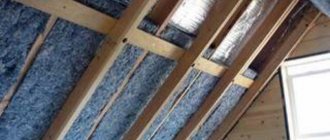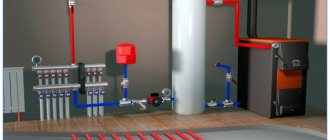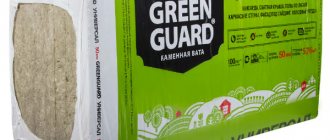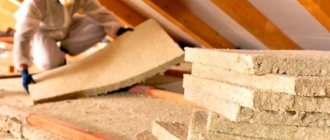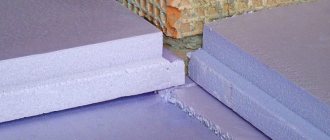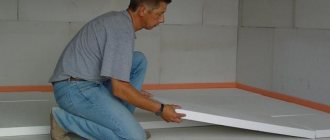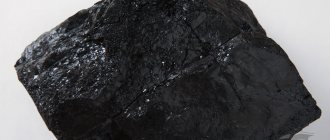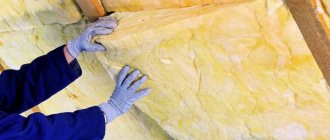Good thermal insulation will not be superfluous at any temperature. If you do it well and choose the right insulation, the house will be more warm in the cold season, and cooler in the summer heat. Knowing what types of insulation there are , you can easily choose the best option for interior or exterior decoration.
Variety of types of thermal insulators
What types of insulation are there?
There are several criteria for dividing thermal insulators into certain groups. The classification is based on the purpose, form and composition of materials.
Types of insulation according to shape
When choosing a material according to this criterion, you need to take into account what surface it will be mounted on. For external walls, slab or block heat insulators are more suitable. It is better to insulate the inside of the house with fibrous or rolled materials.
Table 1. Types of thermal insulation materials by shape:
| Form | Name | Peculiarities |
| Bulk | Expanded clay, polystyrene, crushed cork | Granular material. Used for filling cavities |
| Loose and fibrous | Ecowool, glass wool | Installation is carried out by blowing into prepared contours or applied by spraying |
| Slab | Foamed concrete, chipboard | Sheets of fixed size and specific shape |
| Rolled | Basalt wool, polyurethane | Flexible, thinner than slabs |
| Block | Foam concrete | Simultaneously performs the function of insulation and supporting structure |
To choose the right insulation, you need to have a good understanding of its types. Then it will last longer and will perform its functions fully.
Types of insulation by composition
This classification is based on the raw materials from which the products are made. Natural-based insulation materials are more suitable for interior decoration, while artificial materials are used for external thermal insulation or for rooms with high humidity.
Table 2. Classification by composition:
| Organic | Inorganic |
| Arbolit | Styrofoam |
| Chipboard | Foamed polyethylene |
| Fibrolite | Penoplex |
| Ecowool | Honeycomb insulation |
| Mineral wool | Expanded polystyrene |
Each type of material has its own set of characteristics. It is used to determine how suitable it is for insulating a particular object.
Types of insulation based on operating principle
Thermal insulation comes in two types – reflective and preventive . The first type reduces heat consumption by lowering the level of infrared light.
Instead of retaining heat, reflective insulation prevents infrared radiation from passing freely through the walls of the home. They do not transmit heat, but reflect it. Most often, aluminum foil is used for these purposes. The surface of this material can reflect 90-97% of the heat that hits it.
Aluminum foil is laid in several layers. The last layer is covered with polyethylene. Such insulation does not take up much space, but at the same time maintains a comfortable microclimate in the house for a long time and at the same time serves as a vapor barrier.
Reflective type of insulation – aluminum foil
The second type involves the use of insulation with low thermal conductivity. For its manufacture, different groups of materials are used - organic and inorganic. Such heat insulators operate according to a specific mechanism. Their role is to slow down the process of heat passage - so that it does not escape outside for as long as possible.
Reflective type thermal insulation
Insulation materials, called reflective or reflective, work on the principle of slowing down the movement of heat. After all, every building material is capable of absorbing this heat and then radiating it. As is known, heat loss occurs mainly due to the exit of infrared rays from the building. They easily penetrate even materials with low thermal conductivity.
But there are other substances - their surface is capable of reflecting from 97 to 99 percent of the heat reaching it. These are, for example, silver, gold and polished aluminum without impurities. By taking one of these materials and constructing a thermal barrier using polyethylene film, you can get an excellent thermal insulator. Moreover, it will also serve as a vapor barrier. Therefore, it is ideal for insulating a bathhouse or sauna.
Today's reflective insulation is polished aluminum (one or two layers) plus polyethylene foam (one layer). This material is thin, but gives a tangible result. So, with a thickness of such insulation from 1 to 2.5 centimeters, the effect will be the same as when using a fibrous heat insulator from 10 to 27 centimeters thick. As an example, let's name Armofol, Ecofol, Porilex, Penofol.
One of the types of reflective thermal insulation.
Insulation for a wooden house
Wood is considered a special type of material. Walls made from it should be well ventilated and have less contact with moisture. Therefore, not all types of heat insulators are suitable for wooden buildings. Mineral wool or penoizol are most suitable for this purpose.
“Foam plastic cannot be used to insulate a wooden house. It will prevent the tree from “breathing” normally. As a result, condensation forms on the walls, which will lead to the appearance of fungus and mold, and the wood will begin to rot.”
Mineral wool
It has a fibrous structure and is made from molten glass with the addition of rock. It has a good set of characteristics:
- easily withstands high temperatures;
- unaffected by chemicals;
- low thermal conductivity;
- excellent sound insulation;
- elasticity, ease of installation;
- environmental friendliness;
- service life is within 30-80 years.
Available in rolls or slabs. Roll insulation is more often used for large buildings, and slabs for small houses. Does not require additional fixation.
Mineral wool
“When working with it, you must always use protective clothing and a mask.”
Rodents do not eat this material, but if you do not cover it with finishing, they can live in it. Mineral wool can be used to insulate houses made from wooden beams and using frame technology.
Prices for mineral wool
Minvata
Penoizol
The texture resembles ordinary foam, but its mechanism of action is similar to that of a mounting foam. The material is applied to a special frame. Within 24 hours it dries and becomes hard.
Penoizol
Features of penoizol:
- average level of vapor permeability;
- completely fireproof - can go out on its own in case of fire;
- not afraid of moisture;
- during installation it fills the existing voids.
To work with this material you will need special tools.
Mixed
Insulation materials of this group consist of both natural fibers and synthetic ones. The percentage of natural and non-natural materials depends on the manufacturer.
Batting
Batting is a textile material that, in terms of production technology and composition (cotton, wool), is similar to cotton wool, but of a special variety. Batting is used as a lining for warm outerwear.
Batting is made from:
- wool;
- cotton;
- viscose;
- synthetics;
- wool blends - a combination of natural wool (about 30%) with cotton, polyester fibers or viscose;
- textile industry waste - threads, pieces of fabric.
Scope of application in clothing manufacturing:
- work clothes and overalls;
- balaclavas;
- mittens;
- lining for pants and outerwear;
- shoe lining.
Pros of batting:
- hygroscopicity (quickly absorbs and quickly evaporates moisture);
- wear resistance;
- excellent air permeability;
- does not cause allergies;
- low price.
Cons of batting:
- heavy;
- material made from natural wool should be protected from moths;
- over time - rolls off;
- with prolonged use, rarefied areas may form;
- low warming properties (preferably used down to −5°C).
Sherstepon
Sherstepon is a non-woven insulation material produced in Russia. Made from natural animal wool and polyester fibers.
Sherstepon
The sherstepon fabric does not pill, unlike natural wool. Retains heat well, absorbs and removes moisture well.
It is used for the manufacture of outerwear, travel equipment, workwear for active recreation, and hats.
Sherstepon is very easy to care for - it can be washed by hand and machine on a delicate cycle. It is not recommended to squeeze by twisting or at high speeds. It is better to let the water drain spontaneously.
Advantages of Sherstepon:
- hygroscopicity. Quickly absorbs and quickly evaporates moisture;
- durability;
- high hygienic qualities;
- lightness, plasticity;
- holds its shape well.
Disadvantages of shestepon (associated with poor-quality production):
- may become prone to deformation;
- moths may appear;
- static electricity;
- allergy.
Alpolux
Alpolux is a insulation material developed by Austrian technologists for the Russian climate. The insulation composition includes natural merino sheep wool (15% - 30%) and polyester microfibers. Very good for cold climates.
Alpolux
Main uses of Alpolux:
- casual warm clothes (adults and children);
- sportswear for active recreation;
- workwear for cold weather;
- ski equipment (overalls, jackets, hats).
Temperature compliance table:
| Density (g/m²) | Thickness (mm) | Air temperature (°C) |
| 100 | 12 | -5 |
| 150 | 22 | -12 |
| 200 | 27 | -20 |
| 150 + 100 (two layers) | 34 | -25 |
| 150 + 150 (two layers) | 44 | -32 |
| 200 + 150 (two layers) | 49 | -37 |
| 200 + 200 (two layers) | 54 | -45 |
Advantages of Alpolux insulation:
- good breathability (clothing removes moisture well);
- high wear resistance and strength;
- environmentally friendly and hypoallergenic;
- retains its shape well;
- retains body heat well;
- light and elastic;
- does not accumulate odors.
Machine washable (no higher than 40°C, delicate cycle). Ironing at minimum iron temperature is acceptable.
Personal experience of using Alpolux insulation
I used Alpolux when sewing snowboard overalls and children's autumn pants. It is very pleasant to work with since both sides are calendered. The insulation does not move apart in layers and glides well under the foot.
After washing it does not deform or pill, so it is not necessary to quilt it. Personally, I do at least 1-2 securing stitches on larger pieces (like legs, fronts, etc.).
For snowboard overalls, Alpolux 100 g/m² was used for lining, fleece for the back and front, and taffeta for the legs and sleeves. The top layer is entirely made of 3000/3000 membrane.
The women's overalls were designed for good activity, so the insulation was thin. It is very convenient to vary the temperature using thermal underwear and a second layer (underwear). Due to this, I was able to use it in different conditions:
- Rosa Khutor Peak (about −10°C) - thin thermal underwear for snowboarding.
- Rose plateau (about 0°C) - even in thin thermal underwear it was already getting hot and I had to unzip all the ventilation and the central zipper.
- Climbing Elbrus is not much activity, we go slowly. At the top there was snow and wind, the temperature was about −20°C. I’m wearing thick thermal underwear, leggings + long sleeve (fleece) + fleece jacket. It froze during stops. But considering that the membrane perfectly protects from the wind, it was warm almost the entire way to the top.
When sewing demi-season pants, Alpolux insulation 100 g/m² + foil fabric was also used for lining. The top layer consisted of a Vancouver membrane. These pants could be worn comfortably down to −5°C.
Woolstikron
Woolstikron - insulation is made from synthetic and natural fibers (sheep or camel wool up to 70%). Compared to insulation made from polyester fibers, it has excellent wind protection. Can absorb up to 30% moisture and still remain dry. Has good vapor permeability.
Woolstikron
Woolstikron combines the lightness of padding polyester and the properties of wool. It has high heat-protective qualities. Well suited for sewing clothes used in extreme climatic conditions. The unique natural and environmental properties of wool have a beneficial effect on the human body.
What are the sizes of insulation?
Insulation dimensions are an important criterion
What type of insulation is there?
The main criterion when choosing the size of a heat insulator is its thickness. Length and width do not play a big role. They are taken into account only when calculating the required amount of materials. The dimensions of the insulation depend on its type.
Table 3. Insulation dimensions:
| Name | Thickness | Length | Width |
| Styrofoam | 20-100 mm | 500-2000 mm | 1000 mm |
| Penoplex | 20-100 mm | 1200-2400 mm | 600 mm |
| Mineral wool | 46-214 mm | 1176 mm | 566-614 mm |
| Izolon | 3.5-20 mm | From 10 m | 600-1200 mm |
| Arbolit | 250 mm | 500 mm | 200-400 mm |
| Chipboard | 10-22 mm | 1830-2800 mm | 20170-2620 mm |
| Fibrolite | 30-150 mm | 2400-3000 mm | 600-1200 mm |
When purchasing materials, you need to pay attention to the area of the roll or slab. It is usually indicated on the packaging. To calculate how much insulation you will need, you need to do the following:
- Calculate the perimeter of the building - add the length and width. Multiply this amount by 2.
- Measure the height and multiply this value by the perimeter of the house.
- Divide the resulting value by the area of one roll or slab.
- Multiply this number by 0.15.
“It is recommended to lay roll insulation with a small margin. Also, any material is subject to shrinkage, so always add to the calculations 10-15%».
Insulation of the house
To reduce heating costs and keep your home warm for a long time, you need to choose a high-quality heat insulator. If you need to insulate a house from the outside, it is better to use inorganic materials - they are less exposed to the external environment.
Synthetic
The most extensive group of modern materials with high heat-saving characteristics. As a rule, synthetic insulation materials contain polyester fiber.
Sintepon
Sintepon is a non-woven artificial material. Made from polyester fiber. Sintepon can be siliconized - with the addition of silicone fibers bonded thermally. This gives the insulation better restorative properties. Insects and mold do not grow in padding polyester.
Sintepon
This type of insulation is suitable for everyday warm clothing, but is not suitable for sportswear and outdoor activities.
Temperature compliance table:
| Density (g/m²) | Thickness (mm) | Air temperature (°C) |
| 50 | 4 | +15 |
| 80 | 5 | +10 |
| 100 | 7 | +5 |
| 150 | 11 | -5 |
| 200 | 15 | -10 |
| 300 | 30 | -20 |
| 400 | 40 | -25 |
To extend the life of the insulation, try to wash the item as rarely as possible. Follow the washing instructions printed on your clothing. If they are not there, then wash them on a delicate cycle at no more than 30°C and separately from other items. It is better to dry clothes in a horizontal position. Do not use an iron as the insulation may melt due to the low melting point.
Advantages of padding polyester:
- low cost;
- fiber elasticity;
- quick recovery of shape;
- practicality.
Disadvantages of padding polyester:
- static electricity;
- fragility;
- the glue used for production may be toxic;
- not suitable for temperatures below −10°C;
- does not allow air to pass through well.
Personal experience of using padding polyester
I used 200 g padding polyester when sewing bumpers for a baby crib. There was no smell from it, it held its shape well and was soft.
I used synthetic winterizer 100 g/m² when sewing an autumn parka for me and my daughter. The insulation was attached to the lining, which was made of thin taffeta. The top layer of the parka consisted of a Vancouver membrane. The parks were perfect for the off-season, for walking at temperatures around +15°C. For lower temperatures of about +10°C, it was already necessary to wear thick fleece jackets or thermal underwear.
Holofiber
Holofiber is a non-woven material consisting of chemical fibers. It is very practical and lightweight, does not cause allergies, and perfectly restores its shape after repeated use. Does not lose its properties after repeated washing and cleaning. Does not absorb moisture and odors.
Holofiber
Available in the form of: sheets, sheets, tapes, multilayer materials, fiber balls.
Holofiber insulation line:
- HARD and MEDIUM - used in the production of furniture and mattresses, in construction;
- SOFT - used for everyday clothing, workwear, and travel equipment;
- VOLUMETRIC - intended for textile and furniture products;
- FOOT - for the production of shoes;
- BUILD - used in construction;
- PAFS - in the form of balls. Designed for textile and furniture products.
Table of correspondence to the temperature conditions of Holofiber SOFT insulation:
| Density (g/m²) | Thickness (mm) | Air temperature (°C) |
| 70 | 8 | from +10 to +15 |
| 100 | 10 | from +5 to +10 |
| 150 | 15 | from −10 to +5 |
| 200 | 20 | from −20 to −10 |
| 250 | 25 | from −25 to −15 |
| 300 | 30 | from −30 to −20 |
Suitable for both casual wear and sportswear (for active recreation).
Advantages of holofiber:
- does not retain moisture;
- retains its shape;
- light and soft;
- retains heat well;
- antistatic;
- hypoallergenic;
- wear-resistant.
Disadvantages of holofiber:
- not cheap;
- does not take the shape of the body, but “springs” from it.
More detailed information about insulation and its properties can be found on the Holofiber website.
Hollophan
Hollophan is a non-woven material made from polyester fiber, which is formed from a melt of polyethylene terephthalate (PET). Due to its hollow structure, it retains heat well and evaporates excess moisture. You can also find the name of the hollofan - “Alaska”.
Suitable for warming casual and sportswear for any age. Holofane has also found application in sewing workwear.
Temperature compliance table:
| Density (g/m²) | Thickness (mm) | Air temperature (°C) |
| 100 | 10 | +5 |
| 150 | 15 | -5 |
| 200 | 20 | -10 |
| 250 | 25 | -20 |
| 300 | 30 | -25 |
| 350 | 35 | -30 |
Clothes made from holophane can be machine washed up to 40°C.
Advantages of holophane:
- easy;
- hypoallergenic;
- environmentally friendly;
- does not change shape and properties when wet;
- does not retain odors;
- not afraid of high and low temperatures;
- resistant to chemicals;
- wear-resistant.
This insulation has no obvious disadvantages. If you have encountered any troubles when using the holophane, please write about it in the comments to the article.
Thinsulate
Thinsulate is a non-woven material made from synthetic fibers (polyester and olefin). Due to its structure, the insulation has excellent heat-insulating properties. Withstands frosts down to −60°C.
Allows both manual and automatic washing (up to 40°C) and dry cleaning. Do not use an iron, otherwise the insulation will melt.
Scope of application in clothing manufacturing:
- casual;
- for the military;
- for active recreation (winter sports and tourism);
- workwear;
- professional;
- hats and gloves.
Several types of Thinsulate are produced:
- CS (thickness: 3 - 17.5 mm) - used in the production of everyday (urban) outerwear, hats, gloves. The most high-tech and affordable type of insulation. Has a non-woven lining on one side;
- P (thickness: 10 - 21 mm) - designed for the manufacture of children's clothing. It is ahead of other varieties in terms of heat and weight ratio;
- B (thickness: 2 - 8 mm) - a highly specialized type designed for the production of winter and demi-season shoes;
- G - used for insulating sports and professional clothing. The peculiarity of this variety is the ability to dry quickly, moisture resistance and excellent drapability;
- J - used in the manufacture of outerwear, sports items, accessories and haberdashery. It has high compressibility and the ability to take its original shape, as well as compatibility with raincoat and quilted fabrics;
- TIB (thickness: 17 - 25 mm) - designed for creating regular and quilted duvets, blankets, sleeping bags and bedspreads;
- FR (thickness: 12 - 18 mm) - is the most fire resistant. Used for the production of professional fire-resistant clothing (for fire services, the Ministry of Emergency Situations, etc.). It contains meta-reinforced fiber (65%), capable of withstanding long-term thermal loads up to 250°C.
Table of correspondence to the temperature conditions of Thinsulate J insulation:
| Density (g/m²) | Thickness (mm) | Air temperature (°C) |
| 60 | 8 | +5 |
| 80 | 10 | 0 |
| 100 | 12 | -5 |
| 120 | 14 | -10 |
| 150 | 17 | -15 |
| 200 | 21 | -20 |
| 250 | 25 | -30 |
Advantages of Thinsulate insulation:
- moisture resistance;
- plastic;
- hypoallergenic;
- high thermal insulation properties;
- keeps its shape well.
Disadvantages of Thinsulate insulation:
- lack of wind protection;
- accumulates static electricity;
- the price is above average.
If you have encountered any troubles when using the Thinsulate, please write about it in the comments to the article.
More detailed information about the insulation and its properties can be read on the Thinsulate3M website.
Siberia
Siberia is a Russian-made non-woven material consisting of 100% virgin polyester fiber. Has high heat-saving properties.
Siberia
Advantages of insulation:
- soft;
- ideal for cutting;
- breathes freely;
- lasting;
- environmentally friendly;
- hypoallergenic.
This insulation has no obvious disadvantages. If you have encountered any troubles while operating Siberia, please write about it in the comments to the article.
Siberia insulation line:
- Classic is a universal insulation for a wide range of applications. It is produced in two versions: with a calender (soft crust on both sides) and without a calender. Suitable for workwear, outerwear, travel equipment and home textiles;
| Density (g/m²), Classic | Thickness (mm) | Air temperature (°C) |
| 80 | 6 | from 0 to +5 |
| 100 | 8 | −4 to 0 |
| 150 | 11 | from −9 to −5 |
| 200 | 16 | from −14 to −10 |
| 300 | 22 | from −20 to −15 |
| 150 + 150 +150 (3 layers) | 33 | from −42 to −21 |
- Micro - contains fine-fibered polyester fibers. Suitable for the production of light and thin clothing for sports and outdoor activities;
| Density (g/m²), Micro | Thickness (mm) | Air temperature (°C) |
| 80 | 4 | −4 to 0 |
| 100 | 5 | from −9 to −5 |
| 150 | 7 | from −14 to −10 |
| 200 | 10 | from −19 to −15 |
| 300 | 17 | from −25 to −20 |
| 150 + 150 +150 (3 layers) | 21 | from −45 to −26 |
- Velvet - consists of polyester silicone fibers. Designed to ensure that the products are soft and very pleasant to the touch. It is also available in two versions: with and without calender;
| Density (g/m²), Velvet | Thickness (mm) | Air temperature (°C) |
| 100 | 8 | from −5 to 0 |
| 150 | 12 | from −9 to −5 |
| 200 | 16 | from −14 to −10 |
| 300 | 27 | from −20 to −15 |
| 150 + 150 +150 (3 layers) | 36 | from −42 to −21 |
- Husky is a three-layer material consisting of polyester fibers and two ultra-thin layers of polypropylene. Suitable for casual, special and dress wear;
| Density (g/m²), Husky | Thickness (mm) | Air temperature (°C) |
| 180 | 25 | from −17 to −12 |
| 230 | 30 | from −23 to −18 |
- Slim is the thinnest in the Siberia line. Made from the finest fibers, but at the same time has excellent thermal insulation properties. For comparison, the thickness of the standard 100 gram is 10 mm, and the Slim is only 2 mm. Ideal for spring clothes or for clothes that require a lack of volume;
| Density (g/m²), Slim | Thickness (mm) | Air temperature (°C) |
| 100 | 2 | −4 to 0 |
| 120 | 2,2 | from −6 to −4 |
| 150 | 3 | from −9 to −7 |
| 180 | 3,5 | from −12 to −9 |
| 200 | 4 | from −14 to −12 |
- Drops - filler for stuffing pillows, furniture, toys, clothes. Presented in the form of balls (diameter 5 mm). Safe and hypoallergenic. Not afraid of washing;
- Super Drops - like Dpors, is a filler in the form of balls, but with a smaller diameter of 2.5 mm;
- Pooh is an ultra-fine microfiber filling. The feel is in no way inferior to natural down. Suitable for pillows, blankets, toys and home textiles.
Siberia can be washed at 40°C, ironed on synthetic mode, without steam.
Read more information on this insulation on the website of the manufacturer Siberia
Choosing a method of insulation
Insulation of walls can be external and internal: the option with external insulation is more preferable and more effective. But there are situations when it is not possible to insulate the walls from the outside.
For example, a ban by the architectural commission: the building is an architectural monument, the appearance of which is not recommended to be changed. Or when an unheated workroom is discovered behind the wall, in which it is impossible to insulate the walls.
In such cases, internal wall insulation with various types of insulation will be the ideal way out.
Insulating walls from the outside with mineral wool and glass wool is much more effective and efficient than insulating the interior surface of the room with them.
It is necessary to approach the issue of choosing insulation with great responsibility, study the characteristics of each type, and select them taking into account the building materials from which the walls of your house are made.
Incorrectly selected material will not help achieve the desired goal and can only make the situation worse. For example, after improper installation of insulation, the wall not only does not retain heat, but in winter it freezes even more than before.
In most cases, if the wall is not properly sealed, after a certain period of time condensation becomes dangerous for the insulation material and for the wall itself.
The material and the wall are saturated with moisture, as a result the insulation effect is reduced to zero, and the walls of the building begin to gradually collapse from infection with fungus.
Incorrect installation of the structure and improper sealing will be one of the key points of heat loss in the room and contamination of the surface with fungus
In order not to encounter these problems for many years after repair and insulation of the surface, you must strictly adhere to the technical installation recommendations.
Equally important is the correct sealing of the seams of the internal walls of the house, the joints between the insulation boards and the wall surface when it is attached.
Review of manufacturers, or what does the Russian market offer?
Let's look at which manufacturers today supply stone wool to the domestic market of insulating materials:
Knauf: recognized world leader
The most famous manufacturer of stone wool in the whole world is the German concern Knauf. He began producing products in 1932, and in the field of thermal insulation he mainly specializes in basalt fiber, although he sometimes produces fiberglass materials.
Knauf has a fairly well thought out choice of insulation for different house structures, for which they produce as many as five series for roofs, walls, ceilings and partitions. Knauf also has universal mineral wool, which is suitable for any task:
Today Knauf produces stone wool literally for the whole world. But, unfortunately, buyers often complain about the increased rigidity of the slabs, which prick.
Of course, it’s not like glass wool; it’s more likely that there’s just an unpleasant sensation when working with bare hands. On the other hand, no one abroad would even think of working with cotton insulation without gloves.
Rockwool: high quality
No less famous is Rockwool - a Danish company that has been operating since 1909. All its factories use only European equipment, which the company is especially proud of. Stone wool is supplied in the following forms:
By the way, Rockwool also has factories in Russia. Among other advantages of this basalt insulation, users usually note that it does not crumble or shrink, and also pleases with a wide selection of sizes and packaging. Those. It’s quite easy to choose the right option for building your favorite home.
Ursa: expensive equipment
But Ursa have developed a new line of mineral wools. In fact, these are three entire production sites operating as the Ursa Eurasia association. Their main trump card is high-tech equipment. Previously, they worked more with fiberglass boards, but today they use more natural basalt raw materials with acrylic-containing components.
Urs also has factories in Russia, namely in the city of Chudnovo. According to the manufacturer, new high-tech equipment from Europe was also imported there, and therefore you don’t have to worry about quality.
And Russia especially liked the Pureone series. By the way, this manufacturer’s basalt insulation is considered one of the best in terms of sound and heat insulation, although it has insufficient vapor permeability, as some complain.
TechnoNIKOL: for special loads
TechnoNIKOL is one of the most famous manufacturers of basalt insulation in Russia, producing its products under the Rocklight brand:
What’s interesting is that each TechnoNIKOL enterprise has its own laboratory. Thanks to this, multi-stage control is constantly carried out over the products. As a result, TechnoNIKOL received a European level certificate for its products.
And at one time, TechnoNIKOL modernized its production lines and was able to achieve a rather unique property of mineral wool - increased rigidity, thanks to which each basalt tile can withstand a load of up to 7 tons. The manufacturer is also trying to make the insulation unattractive to small rodents, but they love such materials so much.
General information
Materials for thermal insulation are classified according to several criteria.
- By purpose - household, industrial.
- By origin - natural, synthetic.
- By release form - sheet, roll, bulk, sprayed, piece.
- The structure is cellular, fibrous, granular, composite.
- By type of raw material – organic, inorganic.
And all types of insulation, depending on the composition and properties, have a specific scope of application and installation technology. For example, bulk materials are more suitable for horizontal surfaces, fibrous materials need waterproofing, and structures of complex shapes are easier to insulate with sprayed insulation or special piece products.
Thermal insulation for a pipeline outlet unit Source pro-uteplenie.ru
Having understood the features of modern insulation, it will be possible to competently approach their choice.
Video description
The types and methods of using polyethylene foam as insulation are described in this video:
Tow, construction felt
When talking about what types of insulation there are, it is worth mentioning those that are used to insulate the gaps between the crowns of a log house, cracks around window and door frames.
- Felt is a fabric felted from low-grade wool with the addition of paste, plant fibers and chemicals to protect against moths and other insects.
Felt tape Source bitrix-cdn.ru
- Tow is produced from flax and hemp waste, obtaining from them a fibrous material for caulking walls.
Briefly about the main thing
Having studied the properties of thermal insulation materials, we can conclude that each of them is not ideal and is not without its drawbacks. There is no ideal insulation suitable for all purposes. When choosing the best option, you need to take into account the material of the insulated structure, its shape and position in space, operating conditions and other points. For example, fibrous materials that are afraid of moisture are not suitable for the underground parts of the building, and the steam room cannot be insulated with foam plastic, which releases harmful substances when heated.
Characteristics and scope of foam plastic
Polystyrene foam is produced by foaming synthetic masses, resulting in a lightweight porous material consisting mainly of air.
Foam wall insulation
Thanks to production technology, foam plastic has a number of advantages
- low heat transfer coefficient (0.047 W/m*K); not susceptible to rotting and fungus; easy to install and replace.
The scope of application of polystyrene foam as a thermal insulation material is also very wide:
- external and internal thermal insulation for walls; roof insulation; floor insulation.
If we compare polystyrene foam and mineral wool as insulation for the walls of a private house, then the first has more advantages. It not only has a lower thermal conductivity coefficient, but also costs several times less.
In addition, you can work with polystyrene foam without any special skills. Installation consists of laying panels coated with sealant on the walls, on top of which a fixing layer (plaster, drywall or siding) will be applied.

